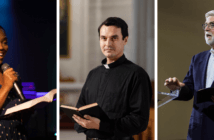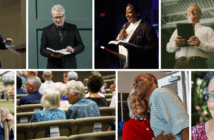Lovett H. Weems, Jr., highlights some of the significant findings in the Lewis Center’s annual Clergy Age Trends Report. Of note is the modest downturn in recent years in the number of clergy under 35 as well as the number and percentage of young women clergy, following a decade of improvement.
![]() Download the 2018 Clergy Age Trends Report.
Download the 2018 Clergy Age Trends Report.
For over ten years, the Lewis Center in partnership with Wespath Benefits has reported annually on the changing age trends among United Methodist clergy in the United States. This research examines active elders, deacons, and local pastors. It reveals several trends in 2018.
1. The number of young elders is holding steady at a somewhat lower level.
After three consecutive years of growth, the number of elders under 35 declined in 2017 and 2018. Growth in the number of young elders had been slow but relatively steady since 2005 when the church had only 850 young elders (4.69 percent of active elders). In 2018, 949 young elders constituted 6.94 percent of active elders. Despite the decline by 54 young elders in the past two years, their relative percentage grew slightly because of the continuing decline in the total number of active elders.
Summary video of 2018 Clergy Age findings. Download this video free.
2. The decline in young women elders continues for the third year.
Virtually all the increase in young elders since 2005 had come from clergywomen. Women as a percentage of young elders went from 31 percent in 2005 to a high of 41 percent in 2015. This year marks the third consecutive year in which both the numbers of under-35 female elders and their percentage of all young elders have declined.
3. Middle-aged and older elders mirror recent trends.
The makeup of middle-aged elders (ages 35 to 54) and older elders (ages 55 to 72) remained proportionately about the same as last year even as their numbers declined. This middle-aged group comprises 37 percent of all active elders, a record low, and down from 65 percent in 2000. The older cohort, between ages 55 and 72, comprise 56 percent of elders in 2017, a record high, and up from 30 percent as recently as 2000.
4. There are fewer active elders and more local pastors.
Since at least the 1980s the number of active elders has declined significantly as the number of local pastors increased dramatically. This pattern continues in 2018. There are 483 fewer active elders and 26 more local pastors in 2018 than in 2017. Since 1990 the number of active elders has declined by 7,838 while the number of local pastor has increased by 3,602 during the same period. As a result, the 1990 ratio of more than five elders for each local pastor has become today a ratio of fewer than two elders for each local pastor. In 2018, there are 13,669 elders and 7,538 local pastors.
5. The age of retirement has declined slightly.
Since 2000 there has been a fairly consistent increase in the age at which clergy retire. The average retirement age increased from just under 64 in 2000 to 66.6 in 2016. But in 2017, the last full year of data, the retirement age across all clergy categories declined to 66.2. Retirement ages for different types of clergy are similar but not the same. In 2017 the average retirement age was 66 for elders, 67 for deacons, 67 for full-time local pastors, and 69 for part-time local pastors.
6. Clergy age distribution is unrepresentative of the U.S. population.
The pattern of clergy age distribution is different than the pattern of age distribution in the U.S. While 24 percent of the U.S. population are 25 through 34 years old, only seven percent of elders, 12 percent of deacons, and eight percent of local pastors are in that age group. Persons of ages 35 through 54 make up 42 percent of the U.S. population; persons in that age group make up 37 percent of elders, 40 percent of deacons, and 34 percent of local pastors. Only 34 percent of the U.S. population are 55 through 72 years old; members of that age group make up 56 percent of elders, 48 percent of deacons, and 58 percent of local pastors.
![]() Download the 2018 Clergy Age Trends Report.
Download the 2018 Clergy Age Trends Report.
Much more information is available in the complete Clergy Age Trends in the United Methodist Church 2018 report, which is available for download free of charge. The full report includes detailed data for every annual conference.
Related Resources
- 5 Reasons the Church Still Needs Young Clergy by Lovett H. Weems, Jr., and Ann A. Michel
- Young Clergy Effectiveness: Good News-Bad News by Doug Powe







